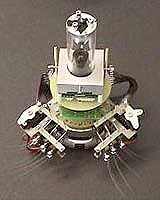Robo-rodent gets 'touchy-feely'
Robots that 'feel' objects and their texture
could soon become a reality thanks to the innovative and interdisciplinary
research of the AMouse, or artificial mouse, project.

Robots that 'feel' objects and their texture could soon become a reality thanks to the innovative and interdisciplinary research of the AMouse, or artificial mouse, project.
But even more important, perhaps, are the lessons researchers learned about robot design and artificial intelligence. The project funded by the Future and Emerging Technologies initiative of the IST programme even developed new insights into biological brain function.
Researchers from Italy, Germany and Switzerland developed a 'feeling' robot by developing a new sensor modelled on hypersensitive mouse whiskers. These AMouse researchers developed a large series of different sensors based on a wide variety of 'whisker' types. These new sensors were then added to mainly standard Khepera research robots.
This not only gave the researchers insight into how mouse whiskers do their job, it also enabled them to develop prototypes that can be used to distinguish between different textures or an object.
------------
Even more exciting, however, were the results from 'multimodal' sensor experiments. These use a combination of vision and touch through whisker and light or camera sensors. The mix of sensory inputs revealed how different data sources affect each other and how they combine to provide a clearer perception of any particular object. Some robots even manifested emergent behaviour.
Emergent behaviour is a primary characteristic of life. In biological systems the combination of various data, like touch and sight, reinforces specific neural pathways. These pathways come to dominate and can cause an entity to 'behave' in a specific way.
In one startling outcome an AMouse robot demonstrated what appeared to be emergent behaviour: it developed a homing instinct without any pre-programming of any kind.
------------
"I think emergent behaviour like this will be a major area in neuroscience and robotics research in the future," says Dr Andreas K. Engel, professor at the University Medical Centre Hamburg and coordinator of the AMouse project.
It will help develop robots that can evolve and it will also teach us much about human cognition. "We can study neural pathways and neural coding in a machine, in a way that's currently impossible in humans. In a robot we can isolate a particular neural pathway to see what happens to other neurons when we trigger a specific one. In humans, if we stimulate one neuron it will influence changes a large number of other neurons, so it's impossible to track what's going on." Engel believes robotic models will offer many exciting insights into human cognition in the future.
Yes, a number of cynical responses leap to mind. Still, robotic research continues apace and separate from the publicity-stunt crap that most often populates mass media.
Posted: Wed - November 16, 2005 at 07:24 AM